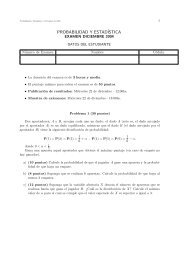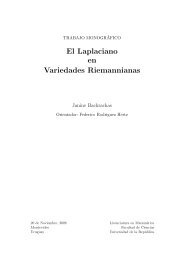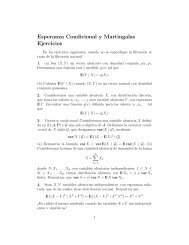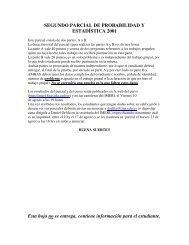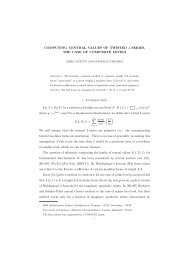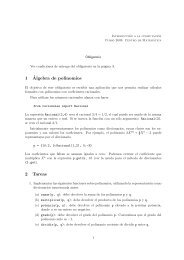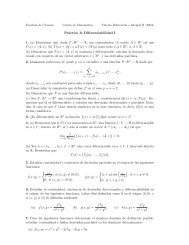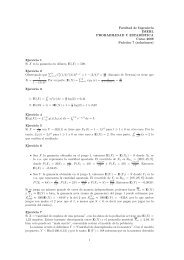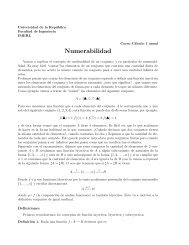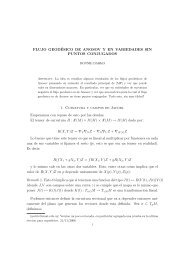CapÃtulos 6 y 7 de Petrov. V.V, Mordecki, E. TeorÃa de la ...
CapÃtulos 6 y 7 de Petrov. V.V, Mordecki, E. TeorÃa de la ...
CapÃtulos 6 y 7 de Petrov. V.V, Mordecki, E. TeorÃa de la ...
You also want an ePaper? Increase the reach of your titles
YUMPU automatically turns print PDFs into web optimized ePapers that Google loves.
6.1. Definiciones y primeras propieda<strong>de</strong>s 7Observación. El lema recién formu<strong>la</strong>do es válido también en el caso en que<strong>la</strong>s funciones <strong>de</strong> u(x) y v(x) <strong>de</strong> argumento real, tomen valores complejos,es <strong>de</strong>cir, si tenemosu(x) = u 1 (x) + iu 2 (x),v(x) = v 1 (x) + iv 2 (x),don<strong>de</strong> u k (x) y v k (x) son funciones <strong>de</strong> argumento real, que toman valoresreales (k = 1, 2). Esto es sencillo <strong>de</strong> <strong>de</strong>mostrar, aplicando el lema anteriora <strong>la</strong>s partes real e imaginaria <strong>de</strong>l producto u(X)v(Y ).Propiedad 6. Consi<strong>de</strong>remos dos variables aleatorias in<strong>de</strong>pendientes Xe Y , con funciones características f(t) y g(t) respectivamente. Sea h(t)<strong>la</strong> función característica <strong>de</strong> <strong>la</strong> suma X + Y . Entonces, se verifica h(t) =f(t)g(t).Demostración. Tenemos)h(t) = E e it(X+Y ) = E(e itX e itY = E e itX E e itY = f(t)g(t),en vista <strong>de</strong> <strong>la</strong> observación posterior al lema 6.1.Es válida <strong>la</strong> siguiente generalización <strong>de</strong> <strong>la</strong> propiedad recién <strong>de</strong>mostrada:si X 1 , X 2 , . . . , X n es un conjunto <strong>de</strong> variables aleatorias mutuamente in<strong>de</strong>pendientes,con funciones características f 1 (t), f 2 (t), . . . , f n (t) respectivamente,entonces, <strong>la</strong> función característica h(t) <strong>de</strong> <strong>la</strong> suma X 1 +X 2 +· · ·+X nes igual al producto <strong>de</strong> <strong>la</strong>s funciones características <strong>de</strong> los sumandos:h(t) = f 1 (t)f 2 (t) · · · f n (t).Propiedad 7. Para todo t real, se verifica f(−t) = f(t).La propiedad anterior se obtiene <strong>de</strong> <strong>la</strong> igualdadf(−t) = E e −itX = E e itX = E e itX = f(t).Definición 6.1. Una variable aleatoria X y su distribución F (x) se dicensimétricas cuando <strong>la</strong>s funciones <strong>de</strong> distribución <strong>de</strong> <strong>la</strong>s variables aleatoriasX y −X son idénticas.Propiedad 8. Si <strong>la</strong> variable aleatoria X es simétrica, su función característicaf(t) es una función real.



